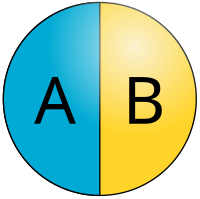
Photo from wikipedia
Electrostatic control and van der Waals integration are useful methods for 2D materials to help modulate their properties. Here, we constructed nine types of monolayer and multilayer Janus structures based… Click to show full abstract
Electrostatic control and van der Waals integration are useful methods for 2D materials to help modulate their properties. Here, we constructed nine types of monolayer and multilayer Janus structures based on group-III monochalcogenides and investigated their atomic and electronic structures from first-principles calculations. We found the existence of an intrinsic electric field at Janus structures by comparing their average vacuum electron potentials at two surfaces. Careful charge analyses reveal that the electric field at monolayer Janus structures is mainly due to the dipole of the bond that connects group-III elements of weaker negativity and group-VI elements of stronger negativity. The E-filed at multilayer Janus structures maintains owing to the superposition of dipole at each layer when layer numbers (LN) are not very large, and the electric field starts to reduce when LN is large enough and obvious charge transfer happens between two surfaces of Janus multilayers. Electronic structure calculations at Janus structures demonstrate that the electric field can hardly modulate the charge density population in the monolayer case, while the electric field will significantly bend the bands in multilayer cases and make the charge density of the valence band maximum and the conduction band minimum always located at two separating surfaces, which promotes electron–hole to separate. Furthermore, we investigated the band alignment of isolated monolayer pristine group-III monochalcogenides and isolated Janus group-III monochalcogenides of monolayer, bilayer, and trilayer, and constructed van der Waals (vdW) heterostructures with one pristine monolayer and one Janus monolayer. The results show that the surface termination of Janus structures at the interface can significantly influence the band offset and electronic structures of vdW heterostructures. These results can not only provide a new understanding of the intrinsic electric field of monolayer and multilayer 2D Janus structures but also give a guide that uses electrostatic to modulate the properties of group-III monochalcogenides and other 2D materials.
Journal Title: APL Materials
Year Published: 2023
Link to full text (if available)
Share on Social Media: Sign Up to like & get
recommendations!